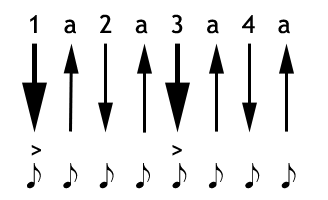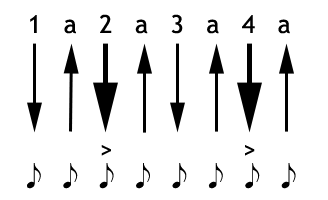Basic Rhythms
In Irish music there are two basic rhythms of importance, the reel and the jig. There are variations of these basic rhythms (e.g. the slip sig) as well as other dances such as hornpipe, polka, waltz — which will not be discussed here, though.
Legend
The following patterns are made up of simple symbols and always represent exactly one full measure of the rhythm. An arrow down stands for a downstroke, an arrow up is an upstroke.
The numbers above the arrows represent the beats in the measure, an "a" stands for "and", a stroke inbewteen full beats of the measure.
Emphasized strokes are indicated by a thick arrow. — Underneath the arrows, you can find conventional musical notes, that again represent the beat. Here, the emphasized beats are identified by a ">" above the respective notes.
The Reel
The reel is a simple rhythm with a four-beat structure(in 4/4 time):

The first and third beats are emphasized. Please note that the third beat in the measure is not the third stroke played. While playing the rhythm, it might be helpful speaking the beats with their emphasis, such as:
"ONE-and-two-and-THREE-and-four-and" or
also
"WA -ter -me -lon -WA -ter
-me -lon"
A variation of the reel puts the emphasis on the second and fouth beat:

Spoken, it sound like this:
"one-and-TWO-and-three-and-FOUR-and"; or
also
"mee-ting-PE-ter -and -his -BEA -ter"
The Jig
The jig is a simple rhythm with a three-beat structure (in 6/8 time):

The first and the fourth beat are emphasized. You can speak this rhythm this way:
"ONE-two-three-FOUR-five-six" or
also
"PINE -ap -ple - A
-pri -cot"
In the reels above, the emphasis always fell on a downstroke. In the jig, an emphasis for the first time coincides with an upstroke. It might get some time used to stressing beat four while keeping the general flow of the rhythm steady.
A variantion of the jig drops the second stroke from the example above. The result is a short interruption with an interesting effect:

"ONE-(skip)-three-FOUR-five-six"
When you have mastered these two jig examplesm you can combine them at will, for instance two measures with variation 1, then two measures with variation 2.
Advanced Aspects
Adanced playing techniques consist of lifting of the left hand (with right handed players) to produce a bass sound. Mind my notes on the matter some place else, though.
Positioning the left hand at different places on the inside of the skin also results in a different sound (variation of pitch), especially when the right hand makes the tipper hit different places of the skin. For instance, it is very impressive to move left and right hand parallel along the skin from the top to the bottom.
The skin hand can also push in the skin with the heel — the result is a higher sound. Then, there is the possibility of a rim shot, where the tipper is not hitting the skin but the frame of the drum. The rim shot should only be used sparingly, though.
Finally, there is the roll (also known as triplet, although it is not a triplet in the classical sense). This is an embellishment where you make three strokes in the same time where usually two occur. This is where at last the upper end of the tipper is used. But since the roll is better shown in a live demonstration than explanined in words, I have decided not to give a complicated abstract explanation here.
Now What?
If you enjoy playing the bodhrán, I suggest you try to find a tutor who can show you the basics in person. Perhaps you can find a friendly Player in your region. If you live in Germany, try the Deutsches Bodhrán Forum.
Further online-tutorials such as this one can be found on the couch links. In the section "Teachers/Workshops" are pieces of information on workshops and "weekends" in Germany, where you can also learn many of the advanced techniques and variations mentioned here, even as a complete newbie to the bodhrán.
Rolf Wagels once named the following essentials for playing the bodhrán:
Clear rhythm, good partitions with the left hand, proper coordination of the right and left hand, conscious and structured play, judicious use of embellishments, clean rolls, volume, if you would like to make Irish music with the bodhrán: knowledge of tunes, and totally important: a feel for the music!Source: bodhran.de
To sum it up: The most important aspect is practise, practise, practise — as with any other instrument. With the sensual bodhrán, though, this is not an ordeal, but a sheer pleasure!